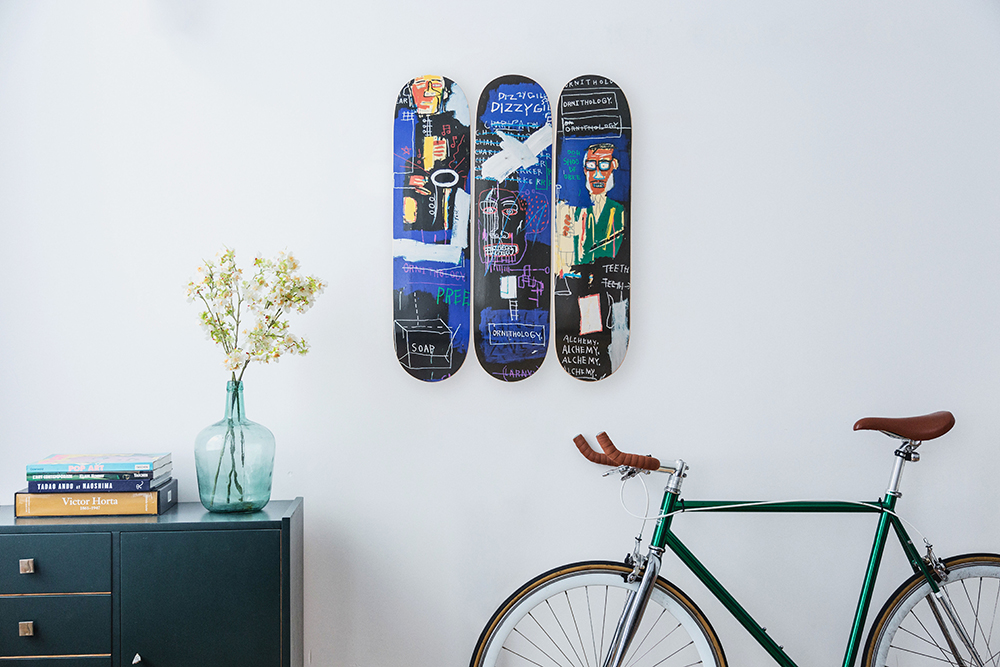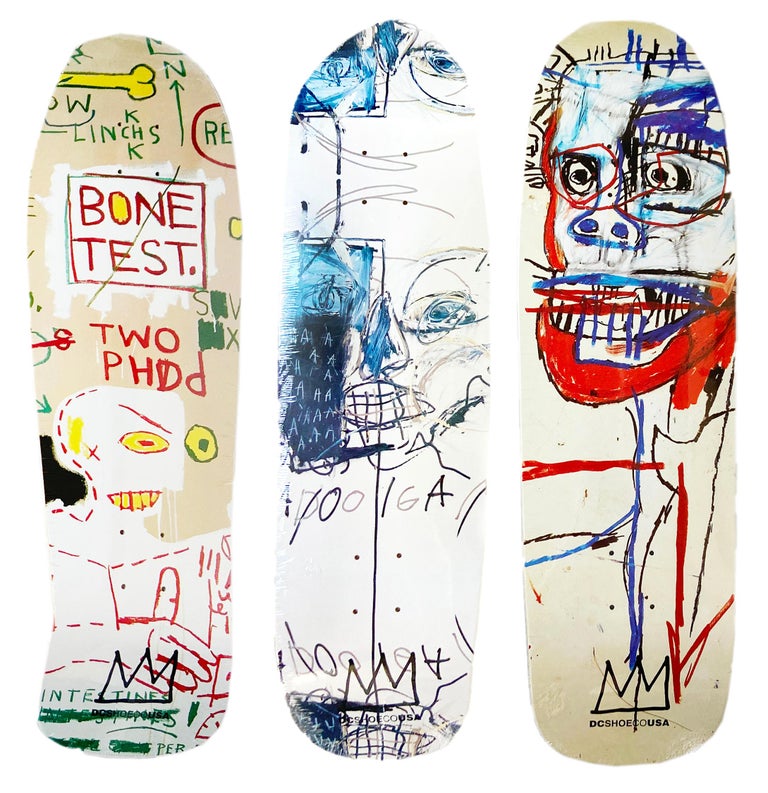So here's something wild that happened in 2019 - Sotheby's auctioned off 248 Supreme skateboard decks, including Basquiat collaborations, for roughly $800,000. Let me repeat that: skateboard decks sold for nearly a million dollars. When I first heard this, I was organizing an art event in Kyiv and literally had to check the news three times to make sure it wasn't fake.
You know, people always ask me why skateboard art became so valuable. Actually, Basquiat's story explains everything about how street culture merged with fine art collecting. The guy started spray-painting cryptic messages on Manhattan walls, and forty years later his skateboard collaborations sell at Sotheby's alongside Rembrandts.
Living in Berlin's art scene taught me one thing: the moment street culture enters a museum, its market value explodes. But with Basquiat? That explosion happened while he was still alive.
Why Basquiat's Neo-Expressionist Technique Revolutionized Skateboard Design
Let me tell you what makes Basquiat's work perfect for skateboard decks - it's that raw, unfinished quality. According to Sotheby's Institute, he commented on cultural history and racial identity by elevating marginalized figures to positions of royalty through his iconic crown symbol.
That three-pointed crown appears on almost every Basquiat skateboard collaboration. Some art historians think it represented himself as a young king, others say it acknowledged artists who influenced him (like Warhol), and honestly... it probably meant all those things simultaneously. That's what made Basquiat brilliant - his symbols carried multiple meanings depending on who was looking.
When I was designing pieces for DeckArts, I studied how Basquiat layered text, symbols, and gestural marks without preliminary sketches. Just pure spontaneous energy flowing onto the surface. It's completely different from Renaissance masters who planned every compositional element, but... actually, both approaches share one principle: creating work that demands attention from across the room.
Back in my Red Bull Ukraine days, I met a graffiti artist who told me: "Basquiat proved you don't need permission to be important." That stuck with me through my move to Berlin four years ago (well, closer to five now, but who's counting).
The $800K Auction: What Supreme's Basquiat Skate Decks Actually Sold For
Here's where the market gets interesting. The 2019 Sotheby's sale wasn't just Basquiat decks - it was the complete Supreme skateboard archive, and the Basquiat collaborations drove much of that $800,000 value.
Breaking down the the Basquiat skateboard market today:
Original Supreme x Basquiat Collaborations (2010-2013): These authorized releases now sell for $3,000-$8,000 individually, depending on which design. The skull triptych? That can push $10,000+ for the complete set.
The Skateroom Editions: Licensed by the Basquiat Estate and Artestar, these range from $350-$900. They're museum-quality reproductions on seven-ply Canadian maple, and unlike bootlegs, they actually support the artist's legacy through the Foundation.
Unauthorized "Inspired" Pieces: Market flooded with these. Worth basically nothing to serious collectors, but some display nicely if you're honest about what they are.
What's fascinating - Basquiat's original paintings now sell for $110.4 million (his 2017 auction record), but his skateboard collaborations remain accessible to collectors who can't drop eight figures on wall art. As I explored in my Skateboard Wall Art on Pinterest: The Most Saved Designs article, social platforms transformed how younger collectors discover art they can actually afford.
 Alt: Basquiat Skateboard Art
Alt: Basquiat Skateboard Art
From Brooklyn Streets to Museum Walls: Basquiat's Skateboard Legacy
Actually, funny story about Basquiat and skateboard culture. He died in 1988, decades before Supreme started collaborating with his estate. But his visual language - those crowns, skulls, warriors, crude text - it basically invented the aesthetic vocabulary that skateboard brands use today.
MyArtBroker describes him as iconoclastic, integrating text and symbols into neo-expressionist work that challenged traditional art hierarchies. That's exactly why skateboard culture embraced him posthumously. Skaters have always rejected establishment rules, and Basquiat literally spray-painted his way into Museum of Modern Art.
Working with Ukrainian streetwear brands taught me how Basquiat's influence permeates fashion, design, and youth culture. His crown symbol appears on everything from luxury handbags to mass-market t-shirts. Some people call it cultural appropriation, others celebrate democratized access to his visual language. I lean toward the second interpretation - Basquiat wanted his art everywhere, not locked in private collections.
When I created our Caravaggio Medusa Skateboard, I thought about this tension between high art and accessibility. Caravaggio's dramatic baroque style served elite patrons, while Basquiat's neo-expressionism deliberately rejected that exclusivity. Yet both artists created visceral emotional impact through bold visual statements.
What Makes Basquiat Skateboard Decks Valuable to Collectors
From my four years navigating Berlin's collector scene, I've learned what separates valuable Basquiat skateboard art from worthless knockoffs:
Authentication Matters Absolutely: Without proper licensing from the Basquiat Estate or documentation from legitimate collaborations (Supreme, The Skateroom, etc.), you own an expensive piece of wood with pretty pictures. That's it.
Condition Dramatically Affects Value: Supreme collectors distinguish between "deck only" (never assembled) and "complete" (with original packaging, stickers, accessories). A mint-condition deck in original shrink wrap can sell for double compared to one with scratches.
Provenance Tells the Story: Can you trace ownership back to the original retailer? That documentation adds significant value. I once saw someone trying to sell a "rare Basquiat deck" on eBay with zero provenance - it sold for $200. The exact same design with proper documentation sold at auction for $4,500.
Edition Size and Year: Early Supreme collaborations (2010-2011) carry more cachet than later releases. Smaller production runs always command premium prices.
Honestly, this is why many younger collectors explore alternatives. Our approach at DeckArts focuses on museum-quality classical art reproductions that don't require authentication headaches. When you display our Bosch Garden of Earthly Delights Triptych, you're getting guaranteed Renaissance masterpiece accuracy without navigating complex provenance issues.
 Alt: Basquiat Skateboard Art: From Street to Auction ($800K Sale)
Alt: Basquiat Skateboard Art: From Street to Auction ($800K Sale)
Neo-Expressionism Meets Skateboard Culture: The Technical Connection
Here's what fascinates me about Basquiat's technique on skateboard surfaces - neo-expressionism actually works better on decks than many other art movements.
His gestural marks, raw energy, layered text... all that visual chaos needs physical texture to fully communicate. Skateboard decks have that slight concave curve, the wood grain showing through, sometimes intentional scratches or wear patterns. It's perfect for Basquiat's aesthetic of rough, immediate, unpolished expression.
Compare that to Renaissance art on skateboards. When I adapt Caravaggio or Botticelli for DeckArts, I'm translating carefully planned compositions onto an unconventional surface. The challenge is maintaining their refinement while acknowledging the skateboard's street culture context.
Basquiat didn't have that problem. His art was born from street culture, so putting it on skateboards feels natural, almost inevitable. As I discussed in my Why Skateboard Art is THE Interior Design Trend of 2026 piece, this authenticity drives current collecting trends. People want art that bridges cultures without feeling forced.
Where to Buy Authentic Basquiat Skateboard Art (And What to Avoid)
From my experience in graphic design and brand authentication, here's where to find legitimate Basquiat skateboard pieces:
Authorized Retailers:
- The Skateroom (official Basquiat Foundation partner)
- MoMA Design Store (carries licensed editions)
- Artsy.net (authenticated secondary market listings)
- Christie's and Sotheby's (for high-value Supreme collaborations)
Red Flags That Scream "Fake":
- No mention of estate licensing or Artestar
- Prices that seem too good ($100 for a "rare Supreme Basquiat")
- Sellers who can't provide authentication certificates
- Listings that say "Basquiat-style" or "inspired by" while charging premium prices
Actually, I should mention - last month someone showed me a "Basquiat skateboard" they bought from a random Instagram account for €500. The quality was awful, obvious digital print with blurry crown symbols. When I pointed out it was unauthorized, they got defensive: "But it looks cool!" Sure, but you paid €500 for a poster glued to wood.
My background working with Ukrainian creative brands taught me: buy from legitimate sources or be honest about owning decorative replicas. Both choices are valid if you're transparent about which you're making.
Investment Potential vs. Living With Art You Love
So anyway, should you invest in Basquiat skateboard decks?
If you have $3,000-$8,000 for authenticated Supreme collaborations, proper storage facilities, and understand you're buying collectibles (not wall art you'll casually display), then yes - the market shows consistent appreciation. The $800K Sotheby's sale proved institutional recognition of skateboard art as legitimate collecting category.
But for most people? I honestly recommend exploring what speaks to you personally rather than chasing investment returns. You'll spend years looking at this art - shouldn't it mean something beyond potential resale value?
At DeckArts, we focus on creating pieces that collectors actually want to live with. Not everyone connects with Basquiat's raw neo-expressionist style. Some people prefer the refined drama of Renaissance masters or the intricate symbolism of Northern European paintings. That's completely valid, you know what I mean?
The best art investment isn't the piece that appreciates fastest - it's the work you'll love looking at for the next decade.
About the Author
Stanislav Arnautov is the founder of DeckArts and a creative director originally from Ukraine, now based in Berlin. With extensive experience in branding, merchandise design, and vector graphics, Stanislav has worked with Ukrainian streetwear brands and organized art events for Red Bull Ukraine. His unique expertise combines classical art knowledge with modern design sensibilities, creating museum-quality skateboard art that bridges Renaissance masterpieces with contemporary culture. Follow him on Instagram, visit his personal website stasarnautov.com, or check out DeckArts on Instagram and explore the curated collection at DeckArts.com.
Article Summary
This article explores Jean-Michel Basquiat's skateboard art legacy, from his neo-expressionist street origins to the 2019 Sotheby's $800K Supreme deck auction. Drawing from my experience in Berlin's art collecting scene and Ukrainian streetwear collaborations, I analyze what makes authenticated Basquiat skateboard collaborations valuable ($3,000-$8,000 range), how his iconic crown symbolism translates to skateboard surfaces, where to buy legitimate pieces versus avoiding fakes, and why his raw aesthetic revolutionized the intersection of street culture and fine art collecting.

